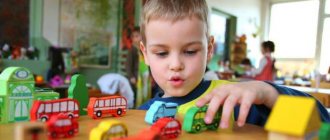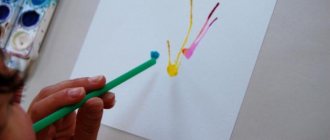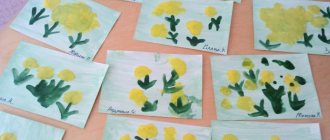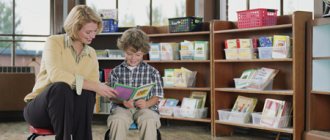Summary of an open lesson on experimental activities in the senior group “Secrets of Snow”
Tasks:
Educational:
• learn to establish basic cause-and-effect relationships and draw independent conclusions and conclusions when conducting experimental research activities
;
• expand children's understanding of the properties of snow
;
Educational:
• develop children’s cognitive interests in the process of research activities
;
• develop creative thinking and activity, independence when conducting research activities
;
• develop the ability to see the diversity of the world in a system of relationships and interdependencies.
Educational:
• cultivate interest in experimental activities
and the desire to do it; independence;
• cultivate a positive attitude towards inanimate nature.
Vocabulary work:
laboratory, experiments
, experiment,
snowfall
, transparent, cloudy.
Materials and equipment: 2 containers with warm water; buckets with shovels; magnifying glasses
, molds, containers with colored water; pieces of ice, black velvet paper, thermos; 3 glasses; plates.
Preliminary work: reading literature, play experimentation and experiments with snow
, ice and water.
Progress of the lesson:
Educator: Guys, today we have an unusual walk. I suggest you talk about snow
, conduct
experiments with snow
like real research scientists.
Scientists work in a room where there are many instruments for experiments
, but what is this room called?
Children: laboratory.
Educator: We will not go to the laboratory alone, guests have come to us. I suggest you say hello:
Let's stand side by side in a circle
Let's say "Hello" to each other.
We are not too lazy to say hello:
Hello everyone and good afternoon.
(When going to the laboratory, along the way, the guys and I remember the rules of behavior: maintain silence, do not interrupt or disturb each other, work quietly, carefully, attentively).
Educator: Guys, I suggest you listen to the riddle and say what time of year this riddle refers to:
Not a bucket
No hand, no arms,
And it will whitewash
All the roofs are around.
(Winter)
Educator: What do you like about winter?
Children: We love winter because we can play in the snow, ski and skate, and we can push each other on sleds. Build a snowman
, slide.
Educator: Well done, guys. What phenomenon in inanimate nature is spoken of in these riddles?
There's a mountain in the yard,
And in the hut - water. ( Snow
)
Transparent like glass
Why don't you put it in the window
. (Ice)
Educator: Today I propose to conduct experiments and find out
, are
snow
, water and ice friends with each other?
I invite you to go through the first experience
, which is called:
Experience 1
.
Why is the snow soft
?
Move.
Educator: For this experience
, I have prepared buckets with shovels for you.
I ask you to collect snow in buckets and collect it in a pile
. Guys, isn't it hard for you? What's the matter?
Children: children note that snow buckets are very light
.
Educator: did you carry sand in them in the summer, and what were the buckets like?
Children: heavy. We had to carry the buckets together.
Educator: Why do you think the snow is so light
?
Children: children's answers.
Educator: If you find it difficult, then I suggest you look at the snow
that fall on black velvet paper, through
a magnifying glass
. What are you observing?
You see that individual snowflakes are linked together. And between the snowflakes there is air, therefore, snow
fluffy and so easy to pick up.
And if we make a lump of snow
, what will it become? And what will it contain less?
Children: heavy, airy.
What conclusion can we draw? Snow is lighter than sand
, since it consists of snowflakes with a lot of air between them.
Children add from personal experience
and name what is heavier than
snow
: water, earth, sand and much more.
Do you know, guys, that when the weather changes, the shape of the snowflakes changes: in severe frost, snowflakes fall in the shape of solid, large stars; in mild frost they resemble white hard balls, which are called cereals; When there is a strong wind, very small snowflakes fly because their rays are broken off. If you walk through the snow in the cold
, you can hear it creaking.
Well done, we coped with the first, I suggest moving on to the second experiment
which is called:
Experience No. 2
.
Why does snow warm
?
Move.
Educator: Guys, you already know that in winter all trees and shrubs must be covered with snow
.
Why do you think? …. What do you think, should the snow be compacted and slammed down around the trees
?
Children: (No).
Educator: Why?
Children: children's reasoning.
Educator: Find it difficult to answer? Guys, in loose snow
, there is a lot of air and it retains heat better.
This can be checked. Before the walk, I poured warm water into two identical bottles and sealed them. I suggest touching them and making sure that the water in both of them is warm. Then we will put one of the bottles in an open place
, we bury the other one in
the snow
without slamming it down. It takes time to check what happened to our water. And so as not to waste time, I suggest you play a little. At the end of the dynamic pause, we put both bottles side by side and compare in which the water has cooled more, find out in which bottle ice appeared on the surface.
Dynamic pause “Water, snow and ice”
»
«Snow
» – children run freely, spin around, making light jumps;
“Water” – slow smooth movement;
“Ice” - children freeze in different poses, using different starting positions (standing, sitting, lying).
After the children have depicted these images in motion, the teacher introduces the signals “Cold” and “Warm”. Children in the form of snowflakes are spinning. Signal:
“Warmth” - children depict melting snow
(from a standing position to a lying position);
“It’s cold” - children freeze in different positions.
Educator: Well done, guys. Let's rest a little, let's see what happened to our water bottles?
Children: children's reasoning.
What can we say about this experience
: The water in the bottle under
the snow has cooled less
, which means
the snow retains heat
.
Great, I have prepared a third experiment
.
Experience No. 3
.
“Are water, snow and ice
?”
Move.
Educator: Guys, for this experience
prepared 3 glasses, water, ice,
snow
.
You need to combine different substances one by one: add snow
, add ice to water in the second glass, and mix
snow and ice
. What do you observe in the three glasses?
Children: in the first place the snow melted
.
Educator: correct, and that the state of the water has changed, the water has become cloudy, but it is getting even colder, that there is more water.
What do you observe in the second glass?
Children: the ice has melted.
Educator: And when water is combined with ice, what does the water become?
Children: remained clear, the water became colder, there was more water.
Educator: Do you and I notice in the third glass?
Children: the snow and ice have not melted
.
Educator: That’s right, when combined, both substances do not interact with each other in any way.
So can we say that water, snow and ice
Are they “friends” with each other?
Children: children's answers.
Educator: who will tell me how the “friendship” of snow
, water and ice can be used in winter, during winter games and fun?
Children: children's reasoning.
Educator: Well done. Guys, have you ever noticed that trees, pipes or wires are white?
Children: children's answers.
Educator: this is laying down
frost. Where did he come from? How do you think?
Children: children's reasoning.
Educator: then I suggest moving on to the next experiment
.
Experience No. 4
. Where does frost come from?
Move.
Educator: Guys, on the table
You see thermoses with hot water.
We open them
and see that, steam. You and I need to hold a cold plate over the steam. What are you observing?
Children: steam turns into water droplets.
Educator: Then we put this steamed plate on the table
and see?
Children: frost is forming on it.
Educator: Correct.
What conclusion can we draw? That our steam, when cooled, turned into water, and thereby the water solidifies and turns into the finest ice crystals, i.e., into frost.
Educator: that's right, well done. And based on our experience
, I propose to conduct 5
experiments
, which is called:
Experience No. 5
. Colored ice toys.
Move.
Educator: For this experience
I have prepared molds and colored water for you.
I suggest pouring water into the molds and leaving them in an open
place to cool. It takes time for our toys to freeze. Therefore, I have prepared ice toys with strings for you in advance and offer to decorate our veranda. But before you decorate the veranda:
Daria M. please tell me what kind of experience
?
Children: Dasha's answer.
Educator: ok, you can hang your toy.
Artem, please tell me what you liked doing?
Children: Artem's answer.
Educator: Great, you can hang your toy.
Daria I. and Arseny, please tell me what kind of experience
?
Children: answers from Dasha and Arseny.
Educator: great, you can hang your toys.
Olga and Vanya, please tell me what exactly you liked about the experiment
with a thermos and a plate?
Children: answers from Olga and Vanya.
Educator: Well done, you can hang up your toys.
Yulia and Maxim, please tell me, was it not difficult for you to carry buckets of snow
? Why?
Children: answers from Yulia and Maxim.
Educator: great, you can decorate your veranda. It's beautiful how it turned out.
Guys, we had a great time experimenting today .
, but our laboratory must close. Goodbye?
Children: goodbye.





